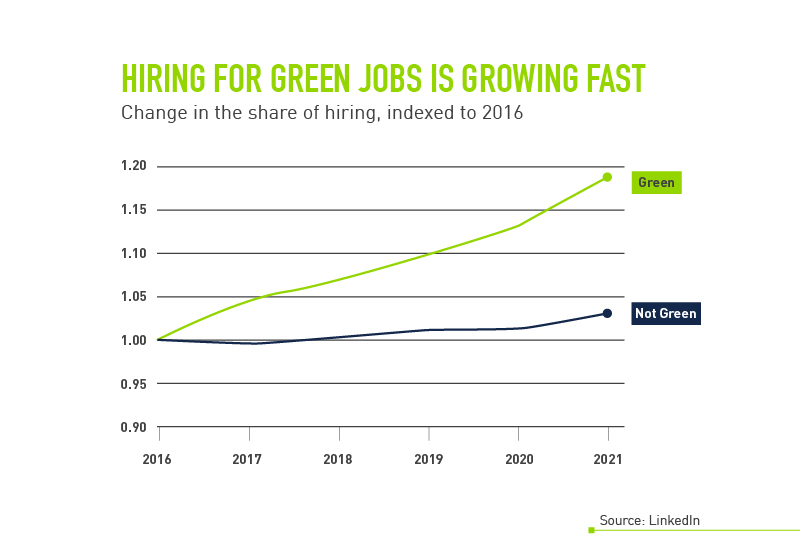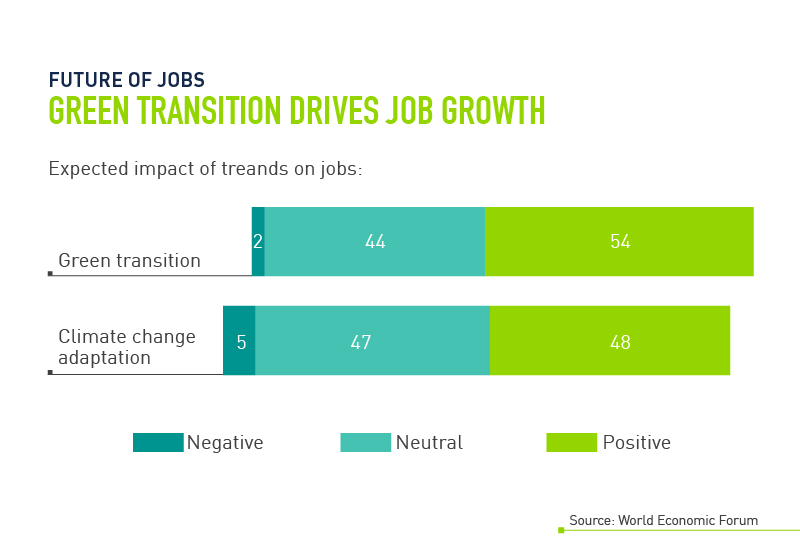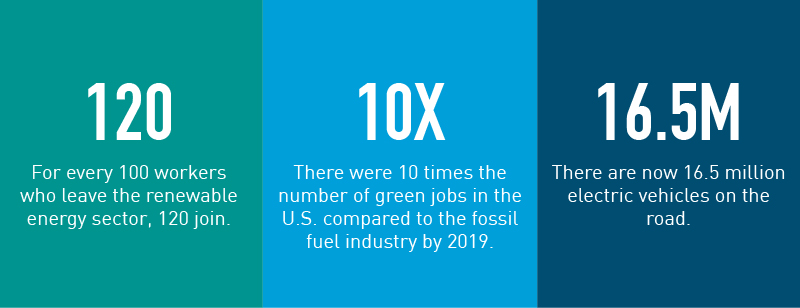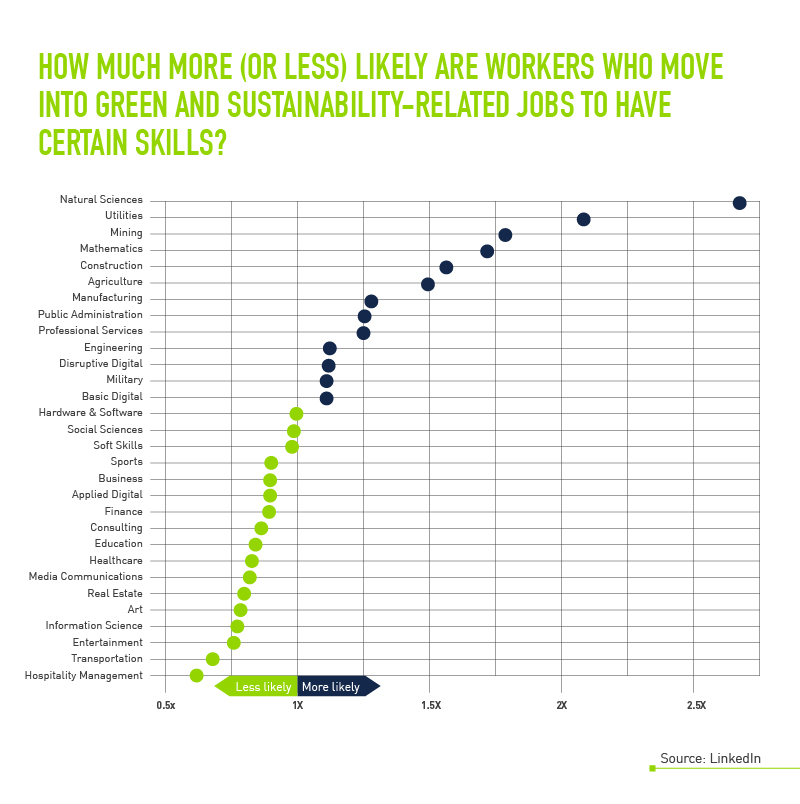Amid the alphabet soup of corporate jargon, buzzwords, and acronyms, you’ll find CSR and ESG. Respectively, the two stand for corporate social responsibility and Environmental, Social, and Governance. These concepts have been around for years but have been growing in importance. Now, CSR and ESG impact talent acquisition in new ways. As candidates become more knowledgeable and passionate about social responsibility and sustainability practices, employers need to respond. The issue is particularly salient for Gen Z, where 87% say it is important to work at a company that aligns with their values.
Job seekers want to work at organizations with values that match their own, with as many as 80% of workers in some industries saying that ESG issues play a role in whether they will resign from or remain at certain organizations.
So, how do CSR and ESG impact talent acquisition? In this article, we explore their impact and outline strategies to help talent leaders incorporate these concepts into their recruitment strategies.
What is Corporate Social Responsibility?
According to the United Nations, corporate social responsibility is “a management concept whereby companies integrate social and environmental concerns in their business operations and interactions with their stakeholders.” CSR focuses on issues including environmental management, eco-efficiency, responsible sourcing, stakeholder engagement, labor standards and working conditions, employee and community relations, social equity, gender balance, human rights, good governance, and anti-corruption measures.
CSR has been growing in importance over the last several decades, according to Harvard Business School, and has led to specific designations like B Corporations (B Corps), social purpose corporations (SPCs), and low-profit limited liability companies (L3Cs). But for many organizations, CSR is simply a self-imposed regulation. Employers can express it through initiatives and strategies and often report back their results through corporate social responsibility reports.
What is Environmental, Social, and Governance?
According to Gartner, Environmental, Social, and Governance (ESG) is “a collection of corporate performance evaluation criteria that assess the robustness of a company’s governance mechanisms and its ability to effectively manage its environmental and social impacts.”
Each pillar of ESG includes different criteria. McKinsey outlines environmental criteria as relating to how much energy a company takes in, how much waste it produces, what resources it requires and how that impacts life around the world. Social criteria address the relationships between an organization and the institutions and communities where it does business. Finally, governance represents the internal procedures and checks and balances an organization uses to make decisions and govern itself.
How CSR and ESG Impact Talent Acquisition
Once little-known terms, these markers of corporate responsibility and sustainability now play a role in job seekers’ decision-making.
One survey found that more than half of employees would not work for a company that doesn’t have strong policies addressing social or environmental sustainability issues. Additionally, 74% of employees said their job is more fulfilling when they’re given the chance to make a positive impact on social and environmental issues, and 70% indicated they’d be more loyal to a company in which they can help contribute to solutions.
The changing environment and increasing pace of climate-related disasters plays a role. Compiled data shows that Google searches for sustainable companies have been growing rapidly since 2016, reaching the highest volume yet in 2023, with no signs of slowing down. In that time, a number of environmental events have dominated headlines, from the devastating 2017 floods caused by Hurricane Harvey in the U.S. to the disastrous 2019-2020 Australian bushfires and 2023 Canadian wildfires. Spikes in searches often follow global climate meetings like the United Nations Climate Change Conferences.
Job seekers are paying attention, and employers can only expect that interest to increase. One survey found that 40% of Gen Z and millennial employees have changed jobs or sectors due to climate concerns or plan to in the future. Additionally, 60% of respondents reported feeling anxious about the environment over the past month, and more than 70% said that they are actively trying to minimize their impact on the environment.
3 Approaches for Including CSR and ESG in Your Recruitment Strategy
To stay ahead of the competition, talent leaders should include CSR and ESG in their talent strategies. Below we outline three approaches.
1. Build a Responsible, Sustainable Employer Brand
Your employer brand is your most powerful tool in attracting top talent, and your ESG and CSR initiatives should be featured throughout your branding materials. Think about your efforts to reduce carbon emissions, support local communities or promote diversity and inclusion. You may measure or report on progress of these initiatives for investors, so consider sharing with candidates as well. Even if you haven’t reached your goals yet, being transparent about your progress can demonstrate to candidates that these initiatives are genuine—not just lip service. Share your next steps and the strategies you have in place for reaching these goals.
There are several ways to showcase your progress to candidates:
- Highlight ESG initiatives in your job descriptions
- Create an ESG page on your career site
- Leverage social media to share your progress toward ESG goals
- Tap into current employees who can share their experiences
- Train recruiters and hiring managers on ESG initiatives
2. Get Employees Involved
Your social responsibility and sustainability goals should be at the core of your culture. Make your goals and initiatives a regular part of conversation rather than distant promise. This will not only help retain top performers but will also help engage candidates.
You can get your employees involved in reaching your CSR and ESG goals by communicating progress and adding performance targets where appropriate. You can also consider benefits that align with your goals so that employees feel as though your commitment to social responsibility and sustainability are part of your DNA, not just marching orders.
Here are a few strategies you can employ:
- Communicate updates on ESG initiatives regularly, like in team meetings or all-company updates
- Encourage leadership to display day-today behaviors that align with goals
- Add ESG-related performance goals
- Consider ESG-related benefits, like days off for volunteer work, a cycle-to-work scheme or vouchers for public transit
- Recognize employees for ESG-related contributions
3. Avoid Greenwashing
As you focus on and promote your social responsibility and sustainability work, avoid falling prey to greenwashing. Greenwashing happens when an organization spends more time and money showcasing sustainability initiatives than actually performing them. It’s often seen as a marketing gimmick, and consumers and candidates are growing more savvy in recognizing it. To maintain a positive reputation and brand perception, ensure that your organization lives up to the values you’re advertising from the top down.
Here are some tips to avoid greenwashing:
- Avoid overly flowery language
- Don’t use dishonest imagery
- Ensure your business practices reflect your marketing promises
- Be honest, even if you aren’t perfect
- Share real data
- Make concrete claims
A Sustainable Future: CSR and ESG in Talent Acquisition
As we move toward a more sustainable future, your CSR and ESG initiatives are important factors for job candidates. The right RPO partner can help you communicate the environmental work you’re already doing to attract top talent. The desire for sustainable employment isn’t going anywhere, and employers should only expect it to get stronger.
Check out our predictions for the future of work in our ebook, Destination 2030: 10 Predictions for What’s NEXT in the World of Work.








![[On-Demand] Ready-to-Go RPO: Introducing PeopleScout Accelerate](https://www.peoplescout.com/wp-content/uploads/2023/07/Accelerate-Webinar-Webpage-Hero-1900x1169-1.jpg)
![Through the job market volatility that has defined the hiring market for the past three years, the travel and hospitality industry saw some of the biggest impacts worldwide, and the reverberations and recovery are still shaping the industry years later. Now, people are traveling again, but while many industries have regained the jobs lost in 2020, hospitality lags behind.
Travelers are finally ready to hit the skies, seas and roads for both personal and business travel.
After several years of staying close to home, pent up demand has the travel industry booming. Global travel revenue is expected to triple 2020 levels by 2027. Full recovery of business travel to 2019 spend volumes appears likely by late 2024 or early 2025.i
Travel is more meaningful than it used to be, leading to increased traveler expectations and more challenges for hospitality staff.
46% of people say travel is now more important to them than it was before the pandemic.ii
43% of people are upping their travel budget in 2023.iii
91% of hospitality workers said they have dealt with customers who believed they inherently deserved privileges or special treatment, and 70% have wanted to leave the industry as a result.iv
However, hospitality staffing has not caught up to the renewed demand.
In the U.S. alone, nearly 2 million hospitality jobs remain unfilled, even as hiring slows in other industries.v
In September 2022, 87% of hoteliers reported staffing shortages.vi
In the UK, hospitality job openings are still 74% higher than they were in January and February of 2020.vii
One big reason for that? Millions of hospitality workers fled the industry during the pandemic and recovery.
15.6% of people left their hospitality jobs in March 2020.viii
8.3% of hospitality staff left the sector between August and September 2022.ix
Do you need help hiring hospitality workers? Learn about how you can attract the next generation of workers, build more diverse teams and plan for the future in The Recruitment Handbook for Hospitality and Travel.
[Download your copy now!]](https://www.peoplescout.com/wp-content/uploads/2023/07/PeopleScout-Travel-and-Hospitality-Infographic-01.jpg)

